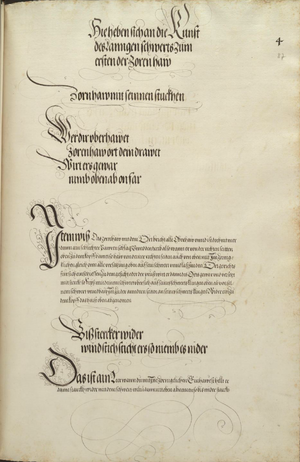|
|
You are not currently logged in. Are you accessing the unsecure (http) portal? Click here to switch to the secure portal. |
Difference between revisions of "User:Kendra Brown/Latin Lew/Piece 018"
Kendra Brown (talk | contribs) |
Kendra Brown (talk | contribs) |
||
| Line 16: | Line 16: | ||
# wind stich sticht ers so niemb es nider | # wind stich sticht ers so niemb es nider | ||
#: | #: | ||
| + | #: | ||
#: | #: | ||
# Das ist ain Leer wann du mit Im zornigclichen Einhawest, | # Das ist ain Leer wann du mit Im zornigclichen Einhawest, | ||
| Line 32: | Line 33: | ||
# twist, thrust. If they thrust<ref>Vienna has ‘sicht’ instead of ‘sticht’, which would read: If they see it [coming]</ref>, then take it downward. | # twist, thrust. If they thrust<ref>Vienna has ‘sicht’ instead of ‘sticht’, which would read: If they see it [coming]</ref>, then take it downward. | ||
#: | #: | ||
| + | #: | ||
#: | #: | ||
# This is a teaching when you strike wrathfully with them: | # This is a teaching when you strike wrathfully with them: | ||
Latest revision as of 04:50, 22 September 2025
Contents
Dresden
German
Transcription
[2] Bisz stercker wider
wind stich sticht ers so niemb es wider
Das ist ain Leer wann du mit Im zornigclichen Einhawest. hellt er. dann starckh wider mit dem schwert. wiltu dann nit oben abnemen. so bis wider starckh
[1] vnnd far auf mit den Armen zu deiner Rechten seite vnd wind die kurtz schneid an seinem Schwert vnnd stich Im oben ein zu dem gesicht. wirt er des stichs gewar. vnd fert auf vnnd versetzt. so bleib du also steen. Inn dem winden vnnd setz Im den ort vnden an.
Sandbox German
- Biß stercker wider
- wind stich sticht ers so niemb es nider
- Das ist ain Leer wann du mit Im zornigclichen Einhawest,
- hellt er dann starckh wider mit dem schwert,
- willtu dann nit oben abnemen,
- so biß wider starckh [87v]
- vnnd far auf mit den Armen zu deiner Rechten seitten vnd wind die kurtz schneid an seinem Schwert vnnd stich Im oben ein zu dem gesicht,
- wirt er des stichs gewar,
- vnd fert auf vnnd versetzt,
- so bleib du also steen Inn dem winden vnnd setz Im den ort unden an •
English
Sandbox English from German
- If you are stronger against [them],
- twist, thrust. If they thrust[1], then take it downward.
- This is a teaching when you strike wrathfully with them:
- If they hold strongly with their sword
- if you don't want to take off above,
- then be strong against [them]
- and move upward with your arms to your right side and twist the short edge on their sword and thrust from above towards their face.
- If they perceive the thrust
- and move up and counteract,
- then you remain in the twists and set the point on them from below.
Smooth English from German
This is a lesson: when you strike wrathfully with them: If they hold strongly with their sword [and] if you don't want to take off above[2], then be strong against [them]; move your arms up on your right side; twist the short edge on their sword; and thrust from above towards their face. If they perceive the thrust, and move up and counteract, then you keep twisting[3] and set the point on them from below.
Munich
Latin
Transcription
[2] Alia cautela
Si contra hostem ira commotus ferias, et is fortiter ensem tenuerit, tuque habitu supra modò commemorato uti volveris, Vicissim et fortiter resistas, brachia inde si versus latus dextrum tuum sustuleris, brevem aciem ab ipsius ense torqueas, atque supernè visum ipsius pungas, at si adversarius id observarit, sublatoque ense impetum exceperit, in intorsione remaneas, et mucronem infernè hosti adiungito.
Sandbox Latin
- Alia cautela.
- Si contra hostem ira co[m]motus ferias,
- et is fortiter ensem tenuerit,
- tuq[ue] habitu supra modò co[m]memorato uti volveris,
- Vicissim et fortiter resistas,
- brachia inde si versus latus dextr[um] tuum sustuleris,
- brevem aciem ab ipsius ense torqueas,
- atq[ue] supernè visum ipsius pungas,
- at si adversarius id observarit,
- sublatoq[ue] ense impetum excep[er]it[4],
- in intorsione remaneas,
- et mucronem infernè hosti adiungito.
English
Sandbox English from Latin
- Another caution.
- If you would strike the ire movement against the enemy,
- and he holds the sword strongly,
- and you wish to use the skill[5] the way it is mentioned above,
- and you resist strongly in turn,
- thence if you would lift the arm toward your right side,
- you would twist the short edge of the sword away from him,
- and thrust at him above in the face,
- but if the adversary observes this,
- (the sword having been lifted) he catches/intercepts the attack),
- you would remain in the wrapping,
- and direct the point to the opponent below.
Smooth English from Latin
If he initially held the sword strongly and you turned as in the action above, and you strike Ire against him, then resist strongly in turn.
If you lifted the arm against your right side, then you should twist the short edge of the sword away from him and thrust above in his face,
But if the adversary observed you doing this, and he caught/intercepted the attack by lifting the sword, then you should continue wrapping and direct the point into the opponent below.


